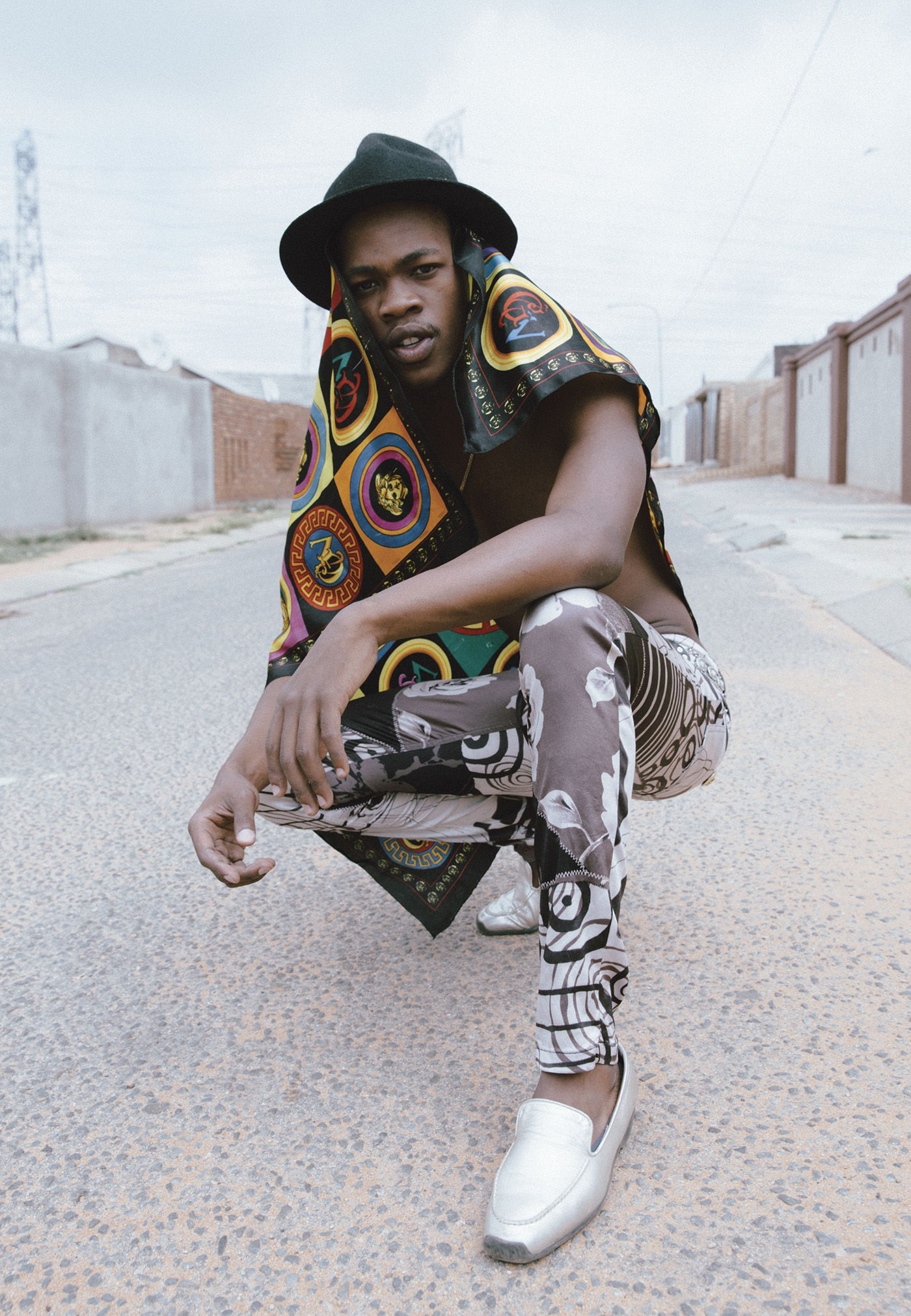Don Dada, otherwise known as Tshepo Pitso, has a bold mission. He wants to turn the South African Izikhothane subculture into a globally recognizable style. Izikhothane emerged from the townships and refers to young people who rock colourful and bold designer gear, drink the finest brands and flaunt their expensive tastes on social media. The subculture had gained notoriety in the South African media, primarily because of ‘battles’ in which Skhothanes compete for superior style. The climax sees auto-destruction with clothes being ripped up, liquors poured out on the floor and money torn into shreds. Such carnivals inspired moral condemnation in the media, which questioned the morality and logic of youth from working class backgrounds brazenly obliterating luxury goods. Typical of this was a presentation of the news show 3rd Degree which ominously described a ‘disturbing new trend… (a) twisted and costly form of one-upmanship’.
Don Dada refutes these allegations of nihilism in the strongest terms. Contrary to the image of ’useless wasteful boys who destroy other kids’ minds’ he promotes Material Boys as a platform for creativity. ‘Don Dada singlehandedly puts talented izikhothane where they belong so that they can be seen. Dancers, graphic designers, musicians, film makers, fashion designers etc- as long as izikhothane does it then we put it on’. Contrary to critics who have dismissed Izikhothane as the local duplicate of the most crassly materialistic aspects of American popular culture, the Don emphasises that it is rooted in everyday township life. As he describes it ‘No celebrity or artist influenced the sub-culture, township fathers influenced township boys that’s why this thing is in the hood and not in the suburbs. People from the suburbs don’t really follow the hood, they are the ones following TV celebrities’. But while the style is influenced by South African street stars, Don Dada aspires to push it far beyond the country’s borders. The Material Boys moniker was chosen precisely because of its simplicity ‘unlike when you say skhothane, then people from Europe or USA they will be asking what it means’. He claims that adherents of this local style are popping up from Zimbabwe to Nigeria. But internationalization flows both ways. The various crew promoted on the Material Boys website take inspiration and phrases from global culture, but repurpose it for their own ends. The Taylor Gang borrow their name from the American record label, while Colata Lavica are inspired by a volcano in Italy. The visual style is hyperreal and bright, their posters abounding with digital images of flowers and lighting. The statement made is of an assertive and unapologetic youth style. Take the slogans of the all-female Unlimited Zilastro Chikitas – ‘Elimination of The Weakest, Survival of the Fittest’ and Undisputed Teflon Traumatizer- ‘Your Trauma will be Unpredictable’. The website even hosts a video of an animated version of Don Dada miming along to Kendrick Lamar’s ‘Swimming Pools’ on the streets of Soweto.

The creativity embodied in the Izikhothane culture has gradually forced more sympathetic coverage from the media, with think pieces detailing how it fits into a historical continuum of township fashion. Going back to the early 20th century, migrant workers in Johannesburg would wear fine suits on weekend to assert their dignity against an oppressive colonial system. Under the even harsher conditions of Apartheid, an entire tsotsi subculture emerged which derived inspiration, in both clothes and illicit activities, from Hollywood gangster films. Going beyond South Africa, it seems safe to say that the 2016 Skhothane can be seen as the latest variation of a figure that he been around since the late 18th century: the dandy. The first dandies were young men, often from humble backgrounds, who adopted aristocratic styles and fashions in class-stratified Europe, becoming figures of both admiration and derision. Their pursuit of a self-created lifestyle, based on commitment to an aesthetic ideal, made them cultural pioneers. This lineage extends into contemporary culture, seen in such dandified stars as the late Davie Bowie, Prince and Young Thug, who combine artistic experimentation with ostentatious dress and defiance of social stereotypes. But even writers sympathetic to the cultural impact of dandies have questioned the true significance of a lifestyle based upon image. The symbolist poet Baudelaire took the gloomy view that dandies were a last gasp of individualism in a conformist society. Albert Camus described the dandy as an actor living out unattainable dreams of social mobility and wealth.
Don Dada has a more hopeful attitude. He suggests that despite the outward appearance, Izikhothane is more about individual freedom than materialism- ‘Material boys are boys who rule material things, who put material where it belongs. We like but we don’t worship material (things) because that won’t make God happy, we take an expensive thing lightly. That’s why it is easy to give it to someone and that’s why we keep getting more and more of the things we like’. In a society where the youth are trapped by unemployment, debt and poverty, the focus of Material Boys is to leverage opportunity. That this is based on the accumulation, and destruction, of consumer goods may at first appear paradoxical. But for Don Dada it’s more about a chance for African youth to develop on their own terms- ‘African kids reflect the shine of their motherland. This shine has always been there, if they are not sure they must think about Egypt 2000 years back!’





















































